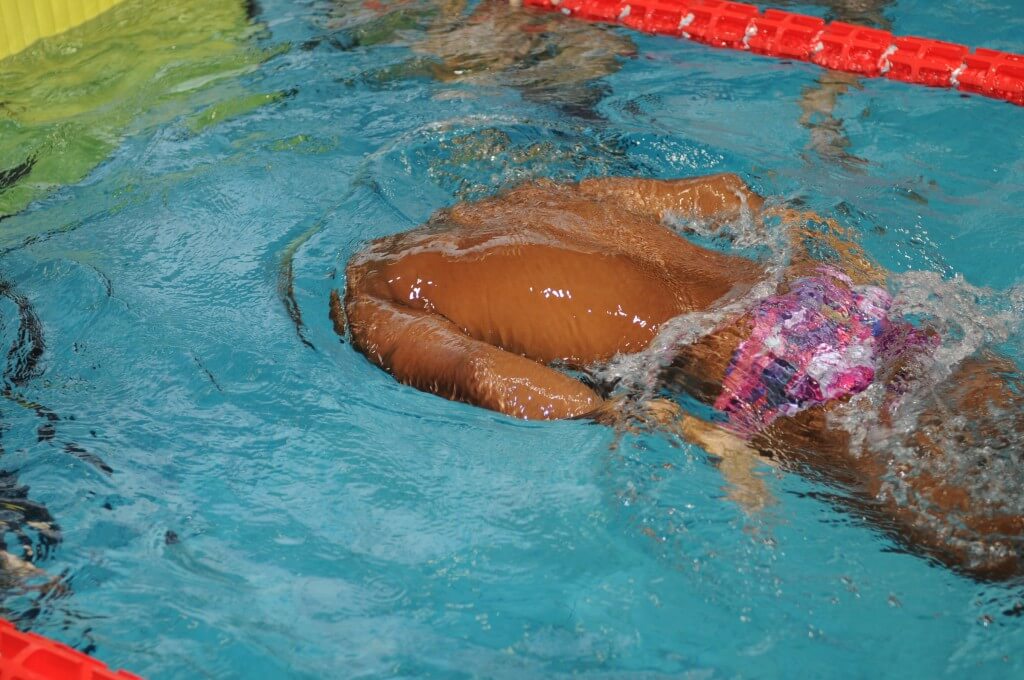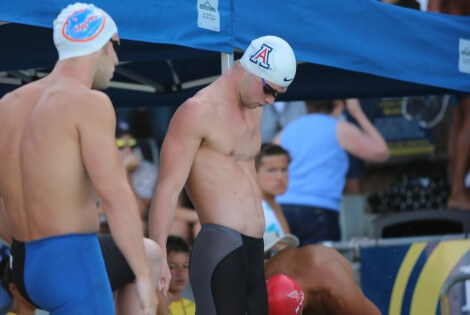6 Ways To Improve Your Flip Turn

6 Ways To Improve Your Flip Turn
By Annie Grevers
How many times have you been told to be quicker on your walls? Not to hesitate before flipping? Get your feet around faster? Probably quite a few times. Turns are not merely a fun accessory in swimming. They’re a crucial part of our sport. How many times have you watched the best swimmer in a heat lose due to poor turns? If you’re looking for a (not so) secret weapon, zero in on your turns.
Here are a few cues for flip turns I’ve found to be productive as a swimmer and a coach…
1. Be Well Rounded

Photo Courtesy: David Farr
Swimmers are not used to rounding their backs in the water. Even though the “swimmer slouch” tells us exactly who the swimmers are on land, that stature isn’t as common in the pool. The flat back we swim with does not roll as well as a rounded back. A roly-poly doesn’t just curl its bottom six legs in to roll forward; its entire exoskeleton curls. The flip cannot be about bringing your knees up and in, your torso needs to take part in the operation.
Picture the moment when your feet are zooming toward the wall. Many swimmers’ heads are aimed directly at the bottom of the pool due to a rigid flat back. To curl your upper body you need to engage your abdominals. If your abs are engaged, the moment your feet dart toward the wall, your head will be facing the opposite end of the pool (exactly where you want your momentum directed). A flip turn should feel much like an upside down crunch. You cannot have a lethal flip turn with a lazy core!
2. Know Where the Wall Is
If your head is your body’s rudder and it’s lifted, your body no longer has its directive. Every time you think you’re taking a ninja glance to see where the wall is, you’re killing a big percentage of your incoming momentum. Inevitably, you lose a large amount of velocity when changing directions, but we want to keep our losses to a minimum. The ‘T’ on the bottom of the pool is there as a point of reference so you can avoid lifting your head. Use the ‘T’! I’ve heard many a swimmer say at meets, “But these ‘T’s are so far from the wall!” Yes, all pools are different. This is why it’s important to use your warmup to acclimate to measurements that may differ from your home pool. Not only do you want to avoid lifting your head into the wall, you want to do the opposite. Tuck your head to roll into that crunch.
3. Don’t Be a Leg Flopper
Knees to chest. Heels to butt. As the narrator clearly states in the video above, “a small shape rotates faster than a large shape.” Rounding your torso will get you around, but not quickly. Semi-straight legs will not only slow your flip, but will not land you in a powerful push-off position. If your legs are at a 120-degree angle, you will not have nearly as much spring as Lochte, whose legs are shown landing at a 90-degree angle. So as your feet fly over your body think, “what would Ryan Lochte do?”
4. Foot Position
Swimmers are not known for their grace, until their feet land on the wall in a perfect ballet plie; not the best launching position. Feet should be hip distance apart. If you’re unsure of your best launching position, do a few squat jumps on land. Try a minimal squat with your feet together. Jump out of it as high as you can. Now try spacing your feet out and come down to a 90-degree squat with a firm core. Jump out of it. I think you’ll feel the difference.
5. “I don’t know what to do with my hands…”
No need to be like Ricky Bobby during your flip turn. Your hands have a job. After taking your final stroke, your feet begin to snap toward the wall. Your hands can help accelerate this process. Drive the palms of your hands down toward the face– as if you’re splashing your water in your face (watch the above video again for a demo). Your elbows should stay close to your body, as your forearms and palms complete the downward drive.
6. Find the Right Depth
Your trajectory off the wall is so important. If your feet are planted too close to the surface, you will have a steep downward trajectory and your momentum will be lost as you attempt to correct the path of your streamline. Or you could push straight into surface water (that turbulent, bubbly, wavy stuff), rather than that peaceful deep water which moves where your feet direct it to move. You probably know the right depth for you based on your push-offs during sets. Allow yourself to go through a few slow flip turns to experiment with foot placement. If you have power, but a poorly-placed foundation, your power will be misdirected.
Your turn. What did I miss?




Maria Garcia Parfitt
Brittany Archer
Vicky Brown
? thank you x
Ahmed Hani
Caileigh McCafferty
Cameron Smith if only session 2 swimmers read this!!!
Yazid Shalaby
Solid Talladega reference, Annie ?
MacKenzie Fox
Mary Lu Thralls!??
Let’s face it, we love anything Annie Grevers writes. ?
Do an open turn it can be faster lol
Robert Cheng
Danielle Carlson
Brian Mezera, you got this!
Ahmad Kanawati
one needs to look at the wall to judge distance for proper turn timing just as Ryan does
Mazen Sakory
Joshua Rodriguez
David Asraf
Ellie Franklin
Thanks I need to practise these again!!
Alex Lawman
When I think of every time I’ve banged my head on the wall!
Jake Bowers
Natalie Farrugia
I learned a trick that speeds up my flip turns–I point my toes when I flip. I don’t know how it works, but it makes my legs flip faster, and my toes find the wall immediately.